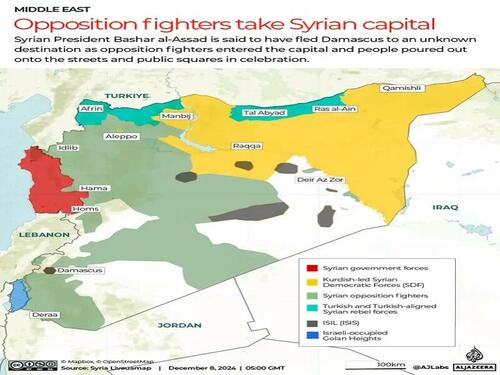Here’s What Has To Happen To Prevent Post-Assad Syria From Collapsing
Authored by Andrew Korybko via substack,
The epic collapse of the Syrian Arab Army (SAA) over the past ten days and Assad’s cowardly flight from Damascus early Sunday morning herald the dawn of a new Syria.
The most immediate risk is that the entire country collapses just like Afghanistan, Iraq, and Libya before it.
That could create a black hole of instability from which innumerable global terrorist threats could emerge. Here’s what has to happen to prevent post-Assad Syria from experiencing that dark future:
1. The Army & The Security Services Must Remain Intact
The three preceding cases of state collapse were characterized by the army and the security services dissolving shortly after their foreign-backed regime change plots succeeded. In Syria’s case, the SAA still exists as an institution even though it’s on the retreat to who knows where, perhaps to the Alawite-majority coast. It’s therefore imperative that it doesn’t fall apart and cooperates with the non-terrorist anti-government opposition (NTAGO) to ensure that everything doesn’t spiral out of control.
2. Political Reform Must Begin Without Delay
Lavrov repeatedly emphasized during his interview at Saturday’s Doha Forum that that the Syrian government and the NTAGO must immediately implement UNSC Resolution 2254 from late 2015, which calls for drastic political reforms such as a new constitution and UN-supervised elections. It was Assad’s refusal to compromise with the NTAGO that ultimately led to this disaster. Prime Minister Jalali will reportedly serve as caretaker leader during the political transition, however, which is a positive sign.
3. The Russian-Written Draft Constitution Must Be Revived
It was assessed late last month that one of “The Five Reasons Why Syria Was Caught By Surprise” is because Assad rejected the Russian-written draft constitution from January 2017’s first Astana Summit, which was constructively critiqued in detail here at the time. With him out of the way, the multiple concessions that this document called for Damascus to make might finally become a reality, and they might even be taken further than its authors initially envisaged given the new circumstances.
4. The Alawite & Kurdish Minorities Must Be Protected
The Alawite coast remains outside the control of Turkish-backed Hayat Tahrir al-Sham (HTS) terrorists for now as does the US-backed Kurdish-controlled northeast, both minorities of which must be protected from the jihadists. To that end, the aforesaid document could lay the basis for broad Bosnian-like federalized autonomy that could result in the coast falling under Russia’s “sphere of influence”, as could the northeast if Trump withdraws US forces from there like RFJ Jr. claimed that he plans to do.
5. The Interim Government Must Maintain Russia’s Bases
And finally, Russia can help the interim Syrian government fight against terrorists just like it helped Assad do from 2015 onward, so they must allow it to maintain its bases for that purpose. Their withdrawal would leave the Syrian state defenseless and the Alawite-majority coast at HTS’ mercy. In fact, since Russia’s intervention in Syria was driven by anti-terrorist motives, it might refuse to withdraw on national security pretexts and possibly midwife an independent coastal state to legitimize its continued presence.
Post-Assad Syria is on the brink of all-out collapse that could turn it into the world’s largest hotbed of terrorism if this process isn’t soon averted.
The most effective way to prevent this from happening is following the five pieces of advice from this analysis.
Anything less would greatly raise the chances of the worst-case scenario transpiring, but even in that event, Russia could still mitigate some of the damage if it continues bombing terrorists in Syria and supports the creation of an independent coastal state.
Tyler Durden
Mon, 12/09/2024 – 23:25


